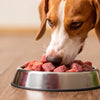How Long Does Raw Dog Food Last Once Defrosted? A Comprehensive Guide for Pet Owners
- Houndsy
Table of Contents
- Introduction
- The Benefits of a Raw Food Diet for Dogs
- How Long Does Defrosted Raw Dog Food Last?
- Thawing Raw Dog Food Safely
- Refreezing Raw Dog Food: Is It Safe?
- Cleaning Up After Feeding
- Transitioning to a Raw Food Diet
- Conclusion
Introduction
Imagine it's mealtime for your furry friend, and you reach for their nutritious raw dog food, only to realize it's still frozen solid. This scenario is all too common for pet owners who have made the switch to a raw diet, which is increasingly praised for its health benefits. As dog lovers, we know that providing our pets with fresh, wholesome food is essential. But what happens once you've defrosted that raw food? Are we doing our pets a disservice by not understanding how long it lasts?
The importance of this topic cannot be overstated. Understanding how to properly handle raw dog food not only ensures the safety and health of our pets but also enhances our overall experience of feeding them. By the end of this blog post, you will learn the key factors influencing the longevity of defrosted raw dog food, safe storage practices, and tips for transitioning to and maintaining a raw food diet.
We will delve into topics such as optimal storage temperatures, recommended time frames for using defrosted food, and practical steps for managing your pet's raw food intake. Let's explore how pet owners can enhance daily feeding routines while ensuring nutritional quality and safety.
The Benefits of a Raw Food Diet for Dogs
Nutritional Superiority
Raw diets are often touted for their ability to closely mimic the ancestral eating habits of dogs. These diets typically include raw meat, organs, and bones, offering a protein-rich and nutrient-dense alternative to traditional kibble. A well-balanced raw diet may boast advantages such as:
- Improved Digestion: Raw food can promote a healthier gut and be easier for pets to digest.
- Shinier Coat and Healthier Skin: The inclusion of essential fatty acids contributes to a gleaming coat.
- Enhanced Energy Levels: Dogs often exhibit more energy and vitality when consuming a nourishing raw diet.
Understanding Storage and Shelf Life
While the benefits of a raw diet are enticing, it’s crucial to handle this food correctly. Understanding how long raw dog food lasts once defrosted protects our pets from potential foodborne illnesses.
Key Factors Influencing Longevity
- Thawing Method: How you thaw your raw dog food significantly affects its durability. The safest approach is to defrost it in the refrigerator. This method prevents bacteria from flourishing, as temperatures remain consistently low.
- Storage Environment: Where you store the thawed food plays a vital role in its freshness. Keeping it in a clean, dedicated space can limit exposure to contaminants.
- Initial Quality: High-quality raw food products tend to have longer shelf lives compared to lesser-quality options, particularly when frozen.
How Long Does Defrosted Raw Dog Food Last?
The general rule of thumb is that defrosted raw dog food should be used within three to five days if stored in the refrigerator. However, several nuances should be considered:
1. Refrigerator Storage
Once you’ve successfully thawed your raw dog food in the refrigerator, it’s essential to consume it promptly. Here is a breakdown of time frames based on thawing methods:
- Refrigerator Thawing: Lasts for 3 to 5 days. This is the preferred method as it minimizes bacteria growth.
- Counter Thawing: If you’ve allowed the food to thaw on the kitchen counter, it should be consumed within 2 to 3 days, given that it has been at room temperature where bacteria multiply rapidly.
2. Signs of Spoilage
Always trust your senses when assessing the freshness of raw dog food. Here are some signs it may be spoiled:
- Unpleasant Odor: Fresh food should smell appetizing. If it emits a foul odor, it’s best to discard it.
- Color Changes: Fresh meat typically has a vibrant color. If it looks dull or gray, this can be a sign it’s past its prime.
- Texture Alterations: Slimy or tacky surfaces are indicators that the food should be thrown away.
3. Optimal Feeding Practices
To ensure that your dog is receiving the best nutrition possible, make it a habit to organize your feeding routine. We recommend:
- Labeling Containers: When dealing with raw food, label containers with thawing dates to keep track of freshness.
- Dedicated Storage: Use designated containers specifically for raw food to minimize the risk of cross-contamination.
Thawing Raw Dog Food Safely
Understanding the different methods for thawing raw dog food is just as critical as knowing how long it lasts once defrosted. Here are the safest methods we recommend:
Refrigerator Thawing
The safest method involves transferring the raw food from the freezer to the refrigerator. Here’s a simple step-by-step guide:
- Remove the raw food from the freezer.
- Place it in a leak-proof container to prevent contamination from other foods.
- Allow it to thaw overnight. A large block may take longer, while smaller portions will thaw more quickly.
Countertop Thawing
If you need a quicker solution, you may choose to thaw raw food on the countertop, but with caution.
- Remove the raw food from the freezer.
- Place it in a safe area on the countertop for no more than two hours to minimize bacteria growth.
- After the initial thawing period, transfer it to the refrigerator to continue thawing.
Using Cold Water
For those in a pinch, place the food (still sealed) into a bowl of cold water. Just remember to change the water every 30 minutes until it is defrosted.
Microwave Thawing: A No-Go
It’s important to note that thawing raw dog food in the microwave is not recommended. Microwaves can create hotspots within the food that allow certain areas to cook, reducing nutritional integrity and increasing the chances of bacteria multiplying.
Refreezing Raw Dog Food: Is It Safe?
Many dog owners wonder whether it’s acceptable to refreeze raw dog food. While it can be done under specific conditions, it’s often not recommended due to potential changes in texture and nutritional quality.
Guidelines for Refreezing
- Only Refreeze if It Was Thawed in the Refrigerator: If you’ve thawed food completely in the fridge, it can be refrozen within 3 to 4 days.
- Avoid Refreezing from Room Temperature: Food thawed at room temperature should not be refrozen.
- Limit Refreezing Cycles: Refreezing meat more than once can lead to significant quality deterioration. It’s best to avoid it when possible.
Cleaning Up After Feeding
Maintaining cleanliness and hygiene is vital when dealing with raw dog food. Here are our top tips for safe post-feeding practices:
- Wash Your Hands: Always wash your hands thoroughly after handling raw dog food.
- Clean Utensils and Surfaces: Use hot, soapy water to clean all dishes, countertops, and utensils that came into contact with raw food.
- Dispose of Leftovers: Any uneaten food should be discarded after two hours at room temperature.
Transitioning to a Raw Food Diet
Switching your pet to a raw food diet can be an excellent way to enhance their nutrition. However, it’s important to transition gradually to avoid digestive upset. Here are a few tips:
- Consult Your Veterinarian: Always discuss dietary changes with your vet to ensure your dog’s health needs are met.
- Start Slow: Begin by mixing raw food with your dog's current food, gradually increasing the raw portion over several days.
- Observe Your Pet: Monitor your dog for any signs of digestive distress or allergies.
Conclusion
Understanding how long raw dog food lasts once defrosted is crucial for every dog owner who wants to provide the best nutrition for their furry friends. By following the proper thawing and storage guidelines, we can prevent spoilage and ensure our pets enjoy fresh, wholesome meals.
If you've found this information insightful, think about how the Houndsy Kibble Dispenser can elevate your daily feeding ritual. With its stylish design and ergonomic features, we make feeding your dog both convenient and stunning. Check out our Houndsy Kibble Dispenser to revolutionize your pet feeding experience!
FAQ Section
How long can defrosted raw dog food be stored?
Defrosted raw dog food should be consumed within three to five days when stored in the refrigerator.
Can I refreeze raw dog food?
You can refreeze raw dog food if it was thawed in the refrigerator, but it should be done within 3-4 days and should not be refrozen more than once.
What are signs that raw dog food has spoiled?
Signs of spoilage include a foul odor, discoloration, and slimy texture. If any of these are present, discard the food immediately.
Is it safe to leave raw dog food out for long periods?
Raw dog food should not sit out for more than two hours. After that, it should be discarded to prevent any risk of bacterial growth.
How should I thaw my raw dog food?
The best thawing methods are in the refrigerator, on the countertop (but only for a short time), or in cold water, avoiding microwave thawing.
With the right knowledge and practices, we can ensure that our pets receive the best care, all while enjoying a beautiful feeding experience with products that enhance our homes. Let’s keep our beloved dogs happy, healthy, and well-fed!













